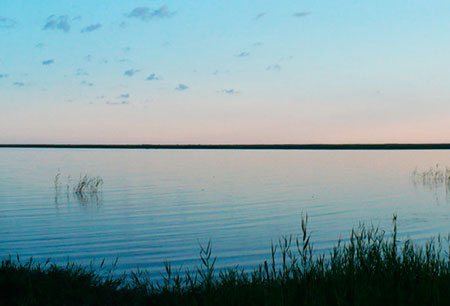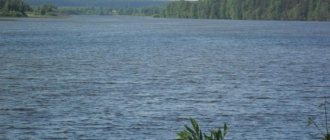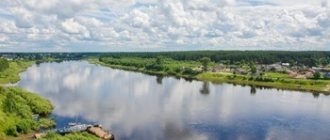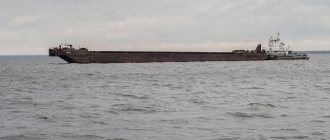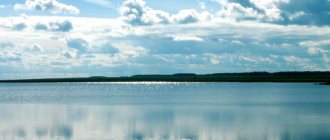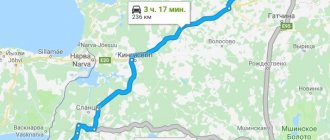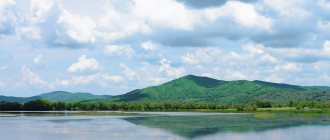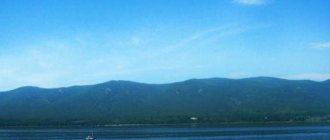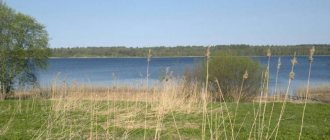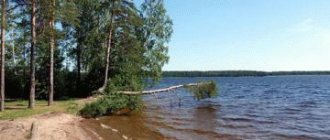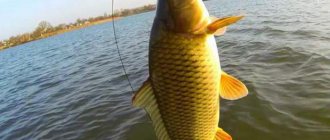LAKE NAME
The lake is called “Chany”, the translation of this name from the Turkic language means “large vessel”. Once upon a time, a long time ago, this lake had an area of 12,000 square kilometers. But due to periodic fluctuations in water levels associated with climate changes, the lake gradually decreased in size.
The size of the reservoir was also influenced by the fact that in the mid-19th century the lake was divided into several reservoirs. Currently, the area of this reservoir ranges from 1500 to 2000 km2, depending on the time of year and precipitation. Among the lakes of vast Russia, this body of water ranks 9th in area.
Lake Chany. GEOGRAPHY
Lake Chany is located in the Novosibirsk region, in the Chanovsky district. This is the largest lake in Western Siberia. Its depth is small, about 2 meters.
Lake Chany consists of small reaches and three large parts: Small Chany, Big Chany and Yarkulya. Both the reaches and large parts of the lake are connected to each other by large and small channels.
Bolshie Chany (length - 91 km, width 88 km) - the largest part of the lake - is located among forests and steppes. Low banks, with a sharply defined line, are overgrown with reeds, sedges and various shrubs in warm seasons. The bottom is mostly sandy, less often muddy.
The water in the reservoir is slightly salted; the lake is filled with water due to precipitation and by the flow of the rivers Kargat and Chulym into the lake.
Vats
Lake Chany
Chany is a closed lake in Russia, located in the Barabinskaya Lowland in the Novosibirsk region, the largest lake in Western Siberia. The lake is located on the territory of five districts: Zdvinsky, Barabinsky, Chanovsky, Kupinsky, Chistoozerny. It got its name from the word chan (Turkic) - a large vessel.
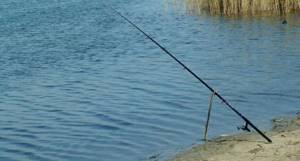
Physiography
Lake Chany is located at an altitude of 106 meters above sea level. The lake is 91 kilometers long and 88 kilometers wide. The area of the lake is variable and currently, according to various estimates, ranges from 1400 to 2000 km². The average depth is about 2 meters, the greatest is 7 meters. The lake basin is flat. The lake is shallow, depths up to 2 meters make up 60% of the total area of the lake. The shores of the lake are quite low and heavily indented, overgrown with reeds, reeds, sedges and bushes. The bottom soil is sandy and silty. The maximum recorded water temperature in summer is 28.3 °C.
Most of the lake is located in the forest-steppe natural zone; the lake is surrounded by steppe from the south.
There are about 70 islands on the lake, the largest are Amelkina Griva, Shuldikov, Lezhan, Medvezhiy, Kolpachok, Chinyaikha, Cheryomukhovy, and Rarediy. The islands of Cheryomushkin, Kobyliy, Perekopny, Bekarev, Kalinova, Chinyaikha, Shipyagin, Krugly, Kolotov, Kamyshny are natural monuments of the region, since they have preserved unique landscapes that are the habitat of rare species of plants and animals.
Among the largest peninsulas are Zelenchak, Kondakov, Golenky, Vaskin, Mys, Drovnikov, Rodyushkin, Kvashnino, Malinikha, Temny, Tyumensky. The islands and peninsulas of the lake have a characteristic feature - most of them extend from southwest to northeast. Their specific location is explained by the fact that they are half-submerged manes.
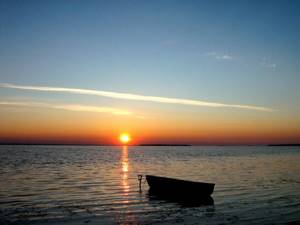
The lake is slightly salty, in the southeastern part of the lake the salinity is lower. The lake is fed mainly by snow, the lake is fed by the Kargat and Chulym rivers. Previously, the Saraika River flowed into the lake, connecting it with Lake Sartlan. The average annual total flow of the Chulym and Kargat rivers is not very significant and amounts to 0.44 km³, while the flows are highly variable. The maximum value of the total flow was reached in 1948 - 1.72 km³, the minimum - in 1968, when it was 0.013 km³ . In 1999 - 2000, the total flow of Kargat and Chulym amounted to 0.134 km³. The inflow of water tends to decrease due to the numerous dams built on the rivers.
The lake is connected by channels to the fresher lakes Malye Chany and Yarkul.
The lake is a system of reaches connected by channels and shallow areas, of which the three largest are Chinyaikha, Tagano-Kazantsevsky and Yarkovsky, differing in water mineralization, area, depths, soils, food supply and abundance of ichthyofauna.
It freezes in the second half of October - the first half of November, and opens in May. The Yarkovsky reach is non-damaged, the remaining areas are periodically dammed.
There is local shipping on the lake.
Climate
The climate in the area of Lake Chanov is continental. The average temperature in January is −19.7 °C, in July - +18.3 °C. The frost-free period lasts from 115 to 120 days. The average annual precipitation is 380 mm. The height of the snow cover is 20-30 cm.
Historical reference
The appearance of the lake is attributed to the end of the Ice Age, approximately 10 - 13 thousand years ago. Initially, the lake was located in a steppe area; the first shrubby birches appeared on the shores of the lake about 5.5 thousand years ago.
Historically, the lake has been characterized by cyclical fluctuations in water levels, which are associated with climate changes that cause periods of high humidity and drought. In addition to seasonal and annual fluctuations, more significant fluctuations lasting 30-45 years were noted. But even taking into account the fluctuations, it has been established that the lake’s area has been shrinking over the past 200 years. At the end of the 18th century, the largest area of the lake in the entire history of observations was recorded - 12,000 km². At the beginning of the 19th century, the area of the lake was already 8,000 square kilometers. In the 1840s, the lake was divided into separate reservoirs and reaches. Since then, the area of the lake has rapidly decreased, and at the end of the 19th century it was only 3170 km². In 1899 - 1914, the lake level rose by 2 meters. At the beginning of the 20th century, the area of the lake was 3,400 km². In 1914 - 1937 there was a drop in level of 3 meters, but in 1920 - 1923 a slight rise of 0.9 meters was noted. The next significant increase in water level was observed in 1937 - 1950. In the 1960s, the area of the lake had already decreased to 2000 km². The range of seasonal and annual fluctuations in water level reached 5 meters.
The first mentions of the lake in Russian sources date back to the 16th - 17th centuries, that is, to the time of the beginning of the development of Siberia. The study of the reservoir began in the 18th century with the settlement of the Barabinskaya Lowland. The first description of the lake was given by the geographer Pallas, who made a trip to Chany in 1786. A more complete description of the lake was given in 1803 by land surveyor V. Filimonov.
Until 1917, the lake was part of the Tomsk province, its territory was divided between Kainsky and Barnaul districts, while most of the lake belonged to Kainsky district. Subsequently, the lake was part of the Novonikolaevsk province, the Siberian region, the West Siberian region, and since 1937 - the Novosibirsk region.
In 1895, hydrological work began on the lake under the leadership of engineer Zhilinsky. In 1911, ichthyologist Skorikov was sent to study the lake, and based on the results of his research, he prepared the scientific work “Lake Fisheries in the Barabinsky District,” containing characteristics of the relief of lake basins, fluctuations in the level and chemical composition of water, the species composition of fish and their feeding conditions. In the summer of 1932, an expedition from Leningrad University appeared on the lake and studied the flora of the lake. In the middle of the 20th century, work began to prevent the lake from drying out. In 1972, for this purpose, with the help of an earthen dam, the Yudinsky Reach, located in the western part of the lake and evaporating a large amount of water, was separated, the area of which at that time was 800 square kilometers (more than 30% of the total area of the lake). The construction of the dam made it possible to raise the water level in the eastern part of the lake by 0.5 meters. The Yudinsky reach began to dry out quickly, and by 1978 the water level in it dropped by 1.1 meters. By the end of the 20th century, the former Yudinsky Reach had practically dried up, the water in it became highly salty, and the water level on different sides of the dam differed by several meters. Despite the disappearance of the stretch, in general the decision to build a dam after 30 years is assessed positively. There is a danger of destruction of the dam, which will lead to water runoff from the flooded part of the lake and an environmental disaster. In 2000, a decision was made to reconstruct the dam. In 2005, funds from the federal budget were allocated for reconstruction.
From 1979 to 1994, the lake's area decreased by 19%. In the 1980s, projects appeared to increase water levels at the expense of other reservoirs. One of them involved attracting water from the Ob River along the bed of the Karasuk River or through a specially built canal, but the project remained unrealized due to lack of funds. It was also proposed to attract excess water from the Vasyugan swamps along the Chulym and Kargat rivers. In 2001, it was proposed to drill about 100 wells at the bottom of the lake to reach aquifers located under the lake at a depth of 900-1200 meters. Fountaining thermal waters, according to the plans of the project authors, will not only prevent the lake from drying out, but also restore its original level.
At the beginning of the 21st century, a further decrease in the area of the lake is predicted, although in 2000-2005 the water level in the lake increased.
Animal and plant life
Lake Chany is home to 16 species of fish. The most numerous: silver crucian carp, perch, carp, ide, pike perch. Roach, pike, and bream have average numbers. Small species: golden crucian carp, peled, dace, tench, lake minnow, gudgeon, verkhovka. The main wintering place for fish is Yarkovsky Plyos and Lake Yarkul. The most abundant fish in the Yarkovsky Reach is perch. In the summer, all the main species of ichthyofauna live in significant numbers in the Chinyaikha Reach; in the Tagano-Kazantsevsky Reach, the most common species are ide, pike perch, carp, crucian carp, with slightly smaller numbers of roach and perch. In low-water conditions, winter kills cause enormous damage to the number of fish, especially valuable commercial species.
During periods of low water, a large number of eggs and juveniles die, so fish farming work is necessary. The lake is regularly stocked with fish, and commercial fish farming is carried out in it. The first fish farming work in the lake began in 1926 - 1927. Initially, carp, carp, and bream were acclimatized. Later, acclimatization of pike perch, peled, tench, nelma, muksun, and Baikal omul was carried out; during the stocking of the lake, verkhovka was accidentally introduced. The first attempts at acclimatization did not achieve much success; no increase in catches was noted. Subsequently, the acclimatization of pike perch turned out to be successful, and it reached large numbers. The bulk of bream dies in low water when death occurs, so its numbers have not yet reached commercial levels. Currently, there is no reliable information about the presence of Baikal omul and nelma in the lake. The failure with omul is explained by the fact that the lake is shallow for this type of fish. Acclimatization of peled was not successful due to the increased mineralization of the water; currently commercial peled farming is carried out, when larvae grown in fish farms are released into the lake, and the fish grow to commercial sizes. In addition, a significant part of the larvae of omul, muksun, peled and nelma were eaten by perch, roach and ide.
In 1976, the Uryumsky fish hatchery was built on the Chulym River, which, among other things, is engaged in the cultivation and stocking of Lake Chany with juvenile carp. Active stocking of juveniles weighing 25 - 80 grams has led to the formation of a large self-reproducing population of carp in the lake. According to observations of the Novosibirsk branch of “Sibrybniiproekt” in 1993, the carp in the number of juveniles that appeared was ahead of the native fish species - roach, ide and perch. The economic crisis of the 1990s led to the fact that the scale of stocking of the lake by the nursery was significantly reduced.
Fish stocks are now significantly depleted compared to the 19th century. For the first time, a reduction in catches of pike, crucian carp and perch was recorded at the end of the 19th century: “... before it was abundant in fish, there were pike weighing up to a pound, crucian carp and perch from 5 to 7 - 8 pounds. Now, for unknown reasons, its wealth of fish has become scarce and the fish themselves have been crushed.” In the 20th century, during periods of high water levels, fish catches reached 10 thousand tons per year, and during low water periods they dropped to 200 tons per year. During periods of low water, the bulk of commercial catches are made up of low-value fish species. Among the main reasons for the reduction in catches are the following: Decrease and sharp fluctuations in water levels. Winter freezes. Freezing to the bottom of a significant part (up to 25%) of the lake in winter. Reducing the scale of fish stocking. Anthropogenic impact. Fishing with nets is officially permitted in the lake upon purchasing the appropriate license. The established fishing quota is 2,800 tons per year. Ichthyologists believe that actual catches significantly exceed official statistics; in addition, poaching has been taking place on a large scale in recent years. An increase in the concentration of phenols, petroleum products, nitrogen compounds and other substances. High mineralization of water in the lake. The highest mineralization of water was noted in the Chinyaikha (6 g/dm³) and Yarkovsky (2.5 g/dm³) reaches.
At the end of the 20th century, a form of silver crucian carp called Amur crucian carp entered the lake. Amur crucian carp has multiplied rapidly over the course of several years, practically displacing golden crucian carp from the lake, which could not withstand its competition, and currently ranks first in catches.
Part of the perch population is infected with gill mites. Opisthorchiasis has not yet been observed in fish from Lake Chany.
The lake plays an important role for the migration of many species of waterfowl: ducks, gulls, geese, waders, swans, terns, coots, shelducks. Rare species of birds on the lake include the white-headed duck, the red-breasted goose, the Asian snipe, the lapwing, the avocet, the stilt, the black-headed gull, the blackeye, the steppe tirkushka, the golden eagle, the white-tailed eagle, and the Dalmatian pelican. Significant concentrations of waterfowl are observed on the lake during periods of migration and molting. . During migration and nesting on the lake there are up to 220 species of birds, according to other sources - up to 300 species of birds. In the 1970s, ornithologists estimated that up to 1.5 million waterfowl visited the lake per season. During the 20th century, there was a steady decline in the number of waterfowl due to mass extermination. For example, in 1930, 9 million eggs were collected in the Chanovsky Lakes system and an even larger number were destroyed. At the beginning of the 21st century, the main anthropogenic factors reducing the number of birds were the destruction of nests during grazing in the coastal part of the lake, and the death of birds in fishing nets.
Among the mammals on the lake, the muskrat lives; in the forest-steppe lands associated with the lake, there are foxes, hares, roe deer, badgers, corsacs, and weasels.
The lake is rich in plankton, both zooplankton and phytoplankton. As of 1983, 404 species of algae were found in the lake. In the Chinyaikha Reach, a high biomass of algae is noted; the strong development of phytoplankton negatively affects the number of fish. The species diversity of zoobenthos is low; chironomids predominate; mollusks, caddisflies, culicids, gammarids, oligochaetes, dragonflies, and mayflies are also found.
Birch, bird cherry, viburnum, aspen, hawthorn, rose hips, currants, raspberries, and ferns grow on the shores and islands of the lake. In the 1940s, oak and forest pine were planted on the northern shore of the lake. On some islands, for example, on Uzkoredky Island, wild peonies grow and bloom.
Nearest settlements
At the end of the 19th century, there were 17 settlements on the shores of the lake, of which 15 belonged to the Kainsky district, and 2 to the Barnaul district. Currently, there are 12 villages on the shores of the lake. None of the settlements on the shore of the lake has the status of a city or urban settlement. On the territory of the Barabinsky district there are Belovo, Kazantsevo, Kvashnino, Novoyarkovo, Staroyarkovo, Bekhten, on the territory of the Kupinsky district - Novorozino, Shaitik, Yarkul, Tyumenka, on the territory of the Chanovsky district - Novoyablonovka and Tagan. The largest villages by population are Kazantsevo, Kvashnino and Yarkul. The reduction in the number of settlements is due to the fact that some villages that were located 100 years ago on the shore of the lake are now located at a considerable distance from it, for example, the village of Yudino in the Chistoozerny district, which was previously located on the shore of the dry Yudinsky reach. At the beginning of the 20th century, there were ancient settlements on some islands, for example, on Bear Island. In the middle of the 20th century, there were agricultural lands on the island where watermelons were grown. There were also rural settlements on Tyumen Island, but now, due to the drying out of the lake, the island has connected with the land. Today, there is no permanent population on any of the islands.
Economy
The lake is of great fishing importance. The adjacent lands are used for haymaking and grazing. Water from the lake is used for technical needs.
Lake Chany is state property. Part of the coastal territory has been taken on long-term lease by commercial organizations.
Scientific research
Since 1971, on the shore of the lake there has been a research base of the Institute of Animal Systematics and Ecology of the Siberian Branch of the Russian Academy of Sciences, where research is carried out on various components of the lake’s ecosystem. At the beginning of the 21st century, the Russian Foundation for Basic Research (RFBR) allocated a grant for hydrological, hydrochemical and hydrobiological research. From 1995 to 1997, excavations of sites dating back to the 6th-7th millennium BC were carried out in the southwestern part of the lake. e. Due to the nature of the area, the cultural layers lie at a depth of only 1 m.
Environmental measures
In 1994, Lake Chany was included in the list of wetlands of world importance. In the northern part of the lake, in the Chanovsky and Barabinsky districts, the Kirzinsky reserve with an area of 1,198 square kilometers was created in 1958. The protection of the lake is carried out by the state hunting supervision service, regional committees for the protection of the environment and natural resources. As environmental measures, restrictions have been established on hunting waders, grazing and haymaking, and there is a ban on drainage activities. Assistance in environmental research is provided by the Dutch Center for Freshwater and Integrated Water Management (Institute for Inland Water, Management and Waste Water Treatment, RIZA).
Tourism and rest
Lake Chany is a popular holiday destination, as well as winter and summer fishing for residents of the Kemerovo, Omsk and Novosibirsk regions. The abundance of waterfowl attracts a large number of hunters. Recreation centers have been built on the shore of the lake, and special tours are organized. Lake Chany poses some danger for vacationers, because in bad weather there are very high waves on it, and there have been cases of death of people who went out on boats into the lake at such times.
Poem dedicated to Lake Chany: Bodrov G.V. "Accept my love, Chans"
THE UNIQUENESS OF LAKE CHANY
The lake is unique not only because of its water system, but also because of its environment. In the vicinity of the Chany lake complex there are 70 islands. The largest are Bear, Amelkina Griva and Cap. Some islands are real natural monuments; they contain unique representatives of the flora and fauna. Stunningly beautiful landscapes, picturesque landscapes - all this pleases and delights.
In addition to the islands, the waters of Lake Chany wash many peninsulas, such as: Vaskin, Golenky, Drovnikov, Zelenchak, Kondakov, Kvashnino, Malinikha, Cape, Rodyushkin, Temny, Tyumensky.
Flora and fauna
- On the coast of Lake Chany, reeds and sedges grow everywhere.
- The shores of the lake are home to 20 species of animals and plants listed in the Red Book of the Russian Federation.
- Lake Yarkul is home to crucian carp and mussels.
- Lake Chany is home to large quantities of silver crucian carp, river perch, carp, ide and common pike perch. Roach, common pike and bream can also be found in small quantities.
- The lake is very important for the migration of waterfowl. Seagulls, ducks and geese live here. Among the rare species, the steppe pigtail, golden eagle and white-tailed eagle were seen.
- Among mammals, the musk rat lives here. Not far from the lake there are wild goats, steppe foxes and Siberian weasels.
- Trees such as bird cherry, trembling poplar and currant grow on the coast and islands.
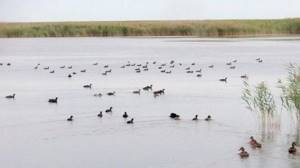
Lake Chany. A LITTLE HISTORY
Scientists suggest that the lake originated during the Ice Age, 10 thousand years ago.
Lake Chany was first mentioned in chronicles at the beginning of the 17th century, when the army of Ataman Sergei Kulagin came ashore. Judging by the records of that time, the lake was six times larger in area than the modern one, it looked like a sea, and the water in it was salty. The area in the vicinity of the lake was not yet inhabited by people, as the Cossacks mentioned the impossibility of finding accommodation for the night.
In 1702, the first tiny village appeared on Bear Island - a settlement of fishermen. But after a few years this place became deserted again - people got scared of something and moved away. And about forty years later, a new settlement arose on Temny Island. The situation repeated itself again - the fishermen left their homes. What is the reason? One geographer and traveler (P. Pallas) noted in his notes in 1787 that fishermen were afraid of a “monster” - a huge snake that supposedly hunted people, tore fishing nets, and rendered boats floating on the water unusable... Was it so? In fact? It still remains a mystery...
And from the beginning of the 19th century, with the expansion of the Tomsk Province, the surrounding areas of the lakes began to be developed by people, and agricultural societies arose.
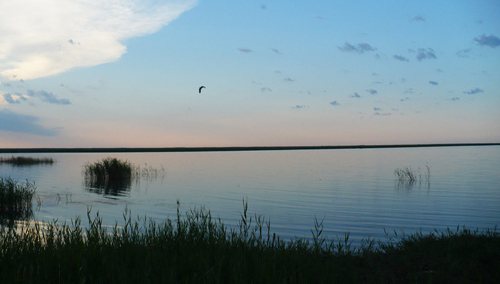
Interesting Facts
Among the most unusual are the following:
- In the Novosibirsk region you can often hear legends that talk about terrible inhabitants of the seabed. According to local beliefs, there is a giant snake here, which repeats the story of the Loch Ness monster. According to residents, the monster feeds on cattle, which are often taken to graze on the shores of the peninsulas. There is no scientific evidence of this fact. Hunters for the monster and scientific expeditions came here repeatedly, but it was not possible to confirm the local legend or find the slightest traces confirming its existence.
- In 2006, representatives and employees of Tohoka University from Japan were detained by security officers at the Novosibirsk airport. They attempted to illegally export samples of water and soil from the reservoir from the country. During the proceedings, it was established that Japanese scientists were also interested in myths about the underwater serpent, and therefore, for the purpose of study, an attempt was made to smuggle natural material.
This is the largest and most beautiful place in the Novosibirsk region for nature lovers. There are unique natural places here that welcome thousands of tourists every year.
Recreation centers are ready to offer visitors an unforgettable experience at any time of the year. The conditions are perfect for people who prefer quiet fishing and exciting hunting to noisy resorts and beaches.
About the secrets of Lake Chany, watch the following video:
ANIMAL AND PLANT WORLD
Lake Chany is considered one of the richest and most beautiful bodies of water in Siberia.
Fishing will greatly please fishermen: the lake is home to 16 species of valuable fish: redfish, dace, golden crucian carp, bream, tench, lake minnow, perch, peled, gudgeon, roach, carp, silver carp, pike perch, pike, ide.
But still, compared to the 19th century, fish stocks have recently become very depleted. Work on breeding and growing fish is constantly required.
Many species of birds migrate to the lake, such as: geese, waders, terns, swans, coots, shelducks, ducks and gulls.
Rare species of birds live in the vicinity of the lake: Asian black-tailed godwit, golden eagle, red-breasted goose, lapwing, avocet, Dalmatian pelican, white-tailed eagle, white-headed duck, steppe tirkushka, stilt, black-headed gull, blackeye.
During migratory periods and molting of birds, a huge number of waterfowl (from 200 to 300 species) gather on the lake.
Among the animals, the muskrat lives on the lake, and in the forest-steppe you can find a badger, a hare, a roe deer, a corsac, and a fox.
The waters of the lake are rich in plankton, which helps the water not be polluted, enriched with oxygen, and also serves as some food for the inhabitants of the lake.
The flora in the vicinity of the lake also pleases with its beauty and diversity: birch, hawthorn, wild peonies, oak, viburnum, forest pine, raspberry, aspen, fern, currant, bird cherry, and rose hips grow here.
Nature of the lake
The diversity of the ichthyofauna is represented by 16 species of fish. The most numerous are silver crucian carp, ide, perch, pike perch, and carp. Pike, roach, and bream are less common. Among the rare species are golden crucian carp, dace, tench, gudgeon, verkhovka, peled, and lake minnow.
The main refuge for fish in winter is the Yarkovsky Reach. This is the only unobstructed place in the lake. In the rest of the water area, due to the lack of oxygen in the water during the cold season, as well as complete freezing to the very bottom, a colossal amount of fish simply die.
The numbers are also affected by sudden changes in water levels, low water levels and, of course, destructive human activities. Since 1926, fish farming work has been carried out on the lake. Every year, fry of carp, peled and other commercial fish are released into Chany.
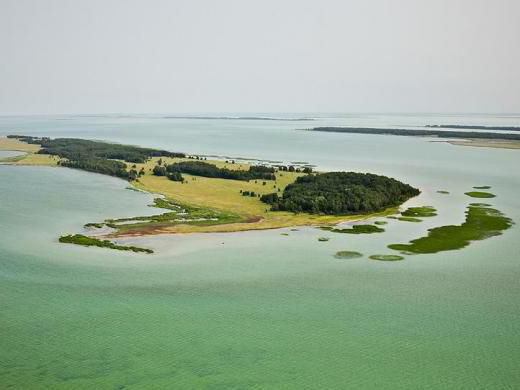
The reservoir is of great importance for many migratory birds. Here you can often find ducks, seagulls, swans, geese, and terns. The vicinity of the lake is home to a large number of rare and endangered species, such as the white-tailed eagle, red-breasted goose, blackbird, and Dalmatian pelican. According to many years of research by naturalists, there are more than 220 species of birds in these places. Ornithologists claim that more than 1.5 million individuals of various birds visit the lake every year.
Among mammals, muskrat is found in Chany, and hares, foxes, badgers, and roe deer are found in the surrounding areas.
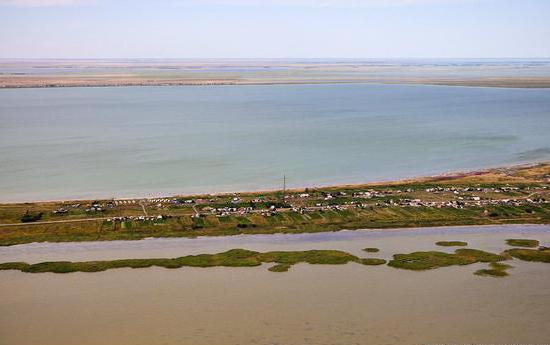
There are 404 species of algae in the lake. The most overgrown is the Chinyaikha Reach. Along the banks, in addition to reeds and reeds, birch, bird cherry, aspen, hawthorn, rose hips, and raspberries grow. On one of the many islands (Uzkoredkom) you can admire entire thickets of wild peonies.
Part of the water area belongs to the Kirzinsky Nature Reserve, where hunting and fishing are prohibited. Poachers will face a hefty fine.
Lake Chany. TOURISM
Tourists will enjoy an unforgettable holiday on the shores of Lake Chany: there is promising fishing, hunting, healing swimming in the reservoir, and fresh air...
Lake Chany is a popular fishing spot. On the northern shores of the lake in 1958, the Kirzinsky nature reserve was even created.
In the vicinity of Lake Chany there are recreation centers where various excursions are organized. Here tourists can also ride a boat, catamaran, windsurf, play football, tennis, and beach volleyball. You are allowed to grill kebabs and cook fish soup. There are a lot of berries in the forests and meadows.
Swimming enthusiasts will delight in the warm and clear waters of Lake Chany. The water in the reservoir sometimes warms up to 26-28 degrees. Celsius. In sunny and calm weather, the surface of the lake turns bright turquoise.
Lake Chany also invites families with small children to its picturesque shores. Beaches with fine sand and the shallow depth of the lake make it a safe place to relax.
Travel lovers should definitely visit Lake Chany! A vacation on the shores of the lake will remain in your memory for the rest of your life.
Recreation on Lake Chany: fishing and hunting
There are many holiday homes and fishing camps on the coast, ready to accommodate those wishing to spend their holidays or weekends on Lake Chany. Especially in winter, many ice fishing enthusiasts try to get there, although summer fishing is no less popular. At some bases, fishing is paid - up to 100 rubles per person, and the time and quantity of fish caught is not limited, as long as only fishing rods or spinning rods are used.
At certain times of the year, when shooting of waterfowl is permitted, hunters come to Lake Chany.
The ripening season of raspberries, boneberries, currants, and strawberries is distinguished by the arrival of berry fruits on the coast; people also come here who want to stock up on mushrooms, hawthorn, and rose hips for the winter.
Many bases offer walks on the lake by boat, catamaran or jet ski, and in winter - on snowmobiles. There are many who want to go on a ski trip around the lake - the nature here is beautiful. Those who come to the coast for corporate events are invariably satisfied: the recreation centers offer barbecue, a sauna or bathhouse, excellent food made from organic products, and, of course, dishes from freshly caught fish. Activities include scooter riding, banana riding, windsurfing and beach sports.
